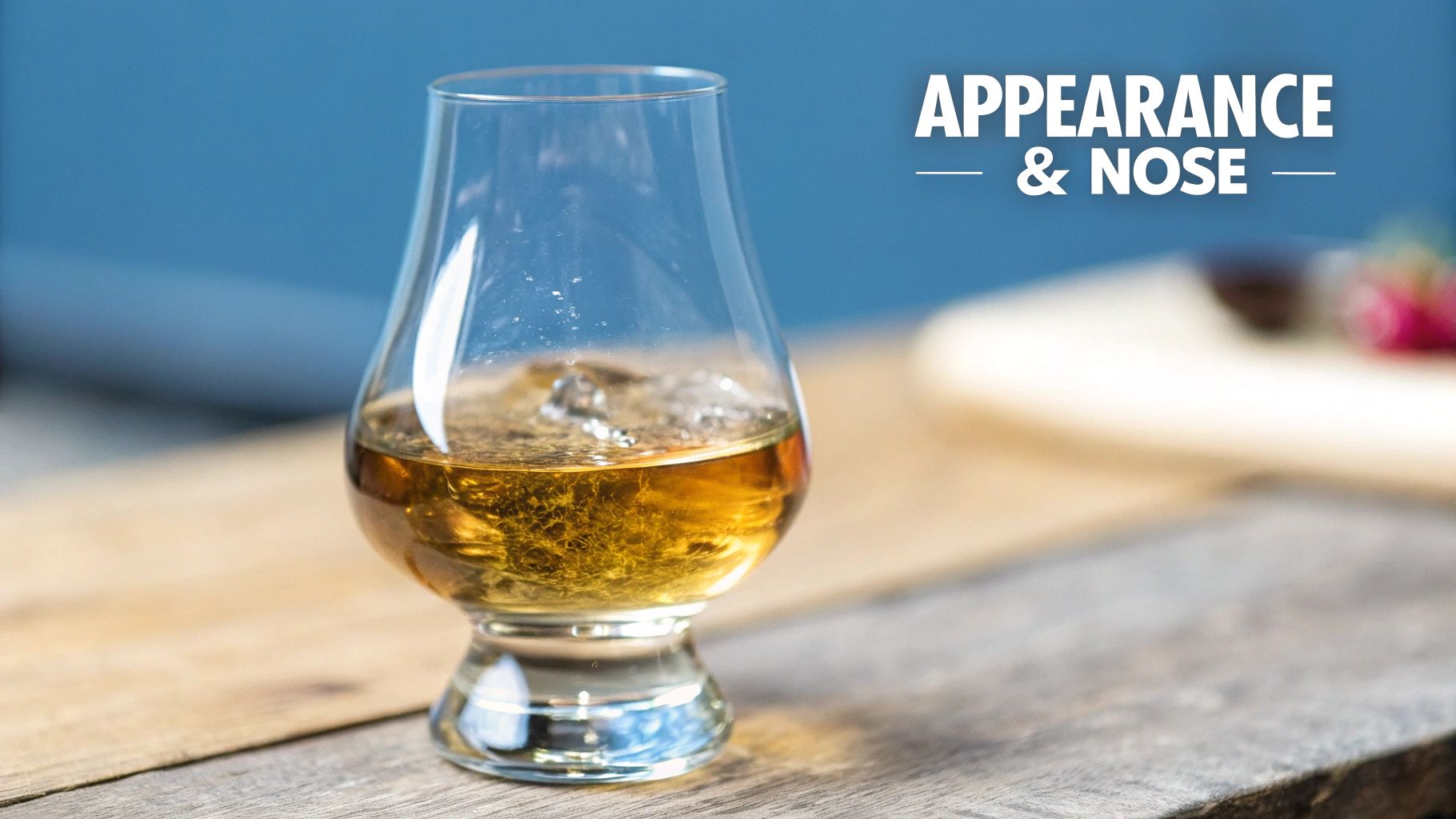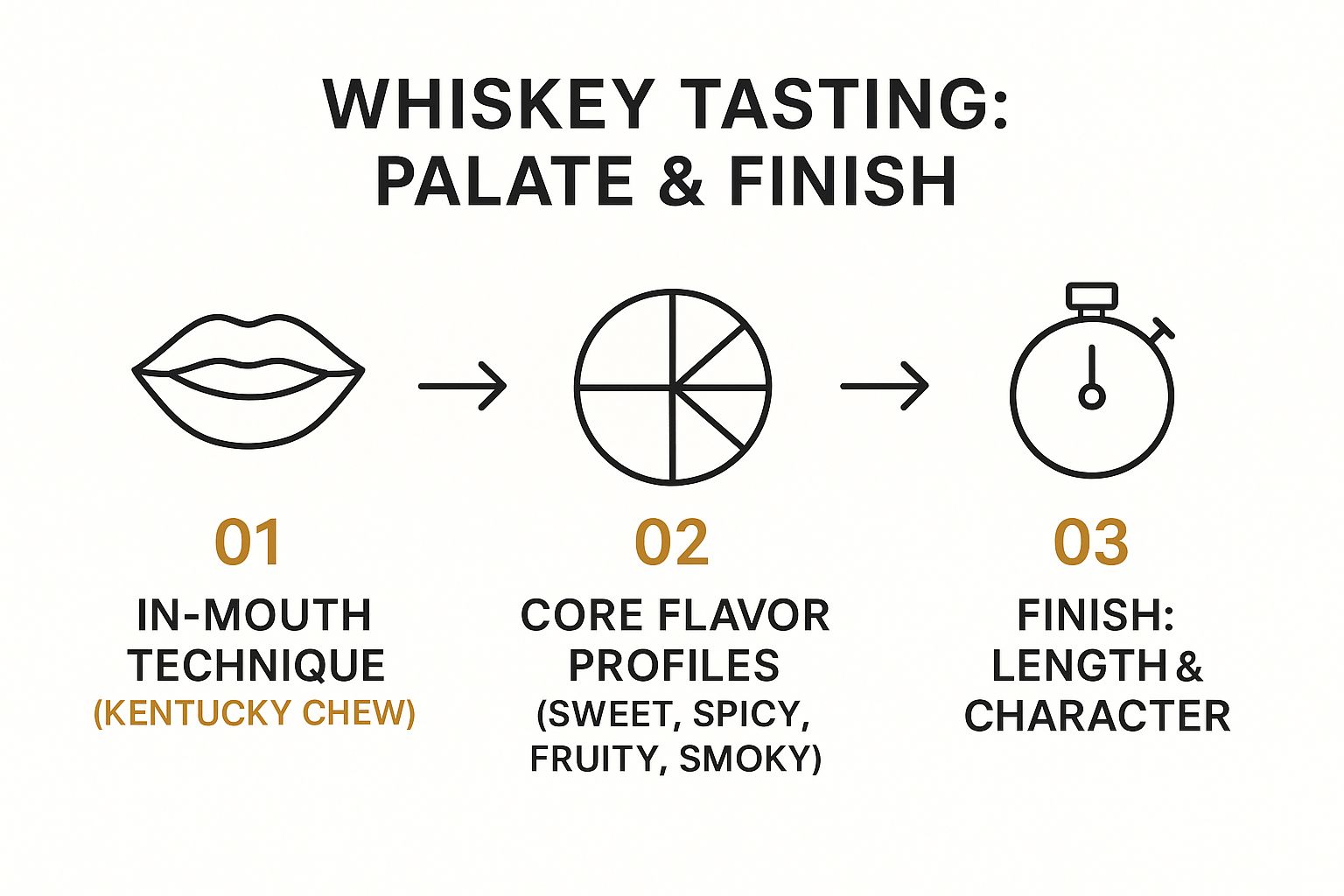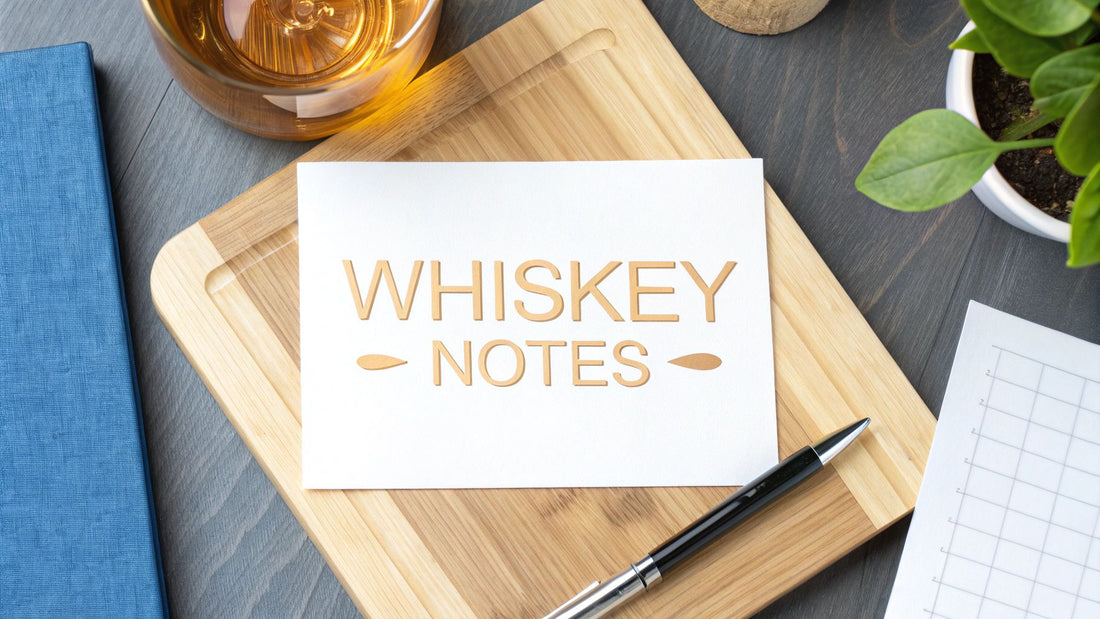A good whiskey tasting notes template is probably the single best tool you can have for turning a casual sip into a real appreciation for what’s in your glass. It gives you a simple, structured way to jot down your observations, which is crucial for spotting those subtle flavors and, over time, building a mental library of what you love. For new whiskey drinkers, this is the fastest way to build confidence and figure out your personal style.
Why a Tasting Template Is Your Secret Weapon
Let’s be honest, walking into a liquor store and seeing a wall of whiskey can be overwhelming. With thousands of bottles staring back at you, how do you even begin to figure out what you genuinely like? A structured approach is the answer, and that’s exactly what a template provides. This isn't about making whiskey more complicated—it's about making it more accessible by giving your thoughts a home.
This is more important now than ever, especially with the American craft whiskey scene absolutely exploding. The market is just flooded with unique expressions from small, independent distillers who are really pushing the envelope. A template helps you make sense of it all, giving you the confidence to try new things. As you start filling pages, learning how to organize your research notes effectively can be a real game-changer for keeping track of your journey.

From Simple Sips to Confident Tasting
The real magic of using a template is that it forces you to slow down and pay attention. You stop tasting "whiskey" and start identifying specific notes and characteristics. Suddenly, your experience shifts from just drinking to actively tasting. This growing interest in mindful tasting is a huge reason the global whiskey market is projected to hit $118.5 billion by 2025. People are moving toward quality and exploration, and a template is the perfect tool for that.
A simple but solid template will always have you focus on four key areas:
- Appearance: What can you tell from the color and the legs in the glass?
- Nose: What aromas hit you before that first sip ever touches your lips?
- Palate: What flavors and textures do you notice when it's in your mouth?
- Finish: What sensations are left behind after you swallow?
By consistently breaking down your tasting into these four steps, you’re basically training your senses. Before you know it, you'll start connecting a deep amber color to notes of caramel and oak, or you’ll recognize a certain aroma as part of a distillery's signature style.
This systematic process is the bedrock of serious tasting, which is why our guide on how to taste whiskey dives deep into each of these steps. It’s all about building a sensory memory bank that makes every future dram that much more rewarding.
Analyzing Appearance and Nose
Long before the first drop ever hits your tongue, the whiskey in your glass is already telling you its story. The first two parts of any good tasting notes template—Appearance and Nose—are all about patient observation. They set the stage for the flavors to come and drop some serious clues about the whiskey's journey from still to bottle.

Your initial assessment starts with just your eyes. Tip the glass toward a neutral light source and give it a gentle swirl. What you see can tell you a surprising amount about the whiskey's age and the type of barrel it called home.
Decoding Color and Legs
A whiskey gets 100% of its color from the wooden cask it matures in, so this is your first real clue about its past. A pale straw or light gold hue might suggest it was aged in a used American oak barrel, a common practice for many single malts. On the other hand, a deeper amber or rich copper, like you'd find in a bourbon from a new-wave craft distillery like Frey Ranch, points to maturation in new, charred oak barrels. You might even spot reddish or ruby tones in whiskeys finished in old wine or sherry casks.
Next, pay attention to the "legs" or "tears" that trickle down the side of the glass after a swirl.
- Thick, slow-moving legs are a good indicator of a higher alcohol content (ABV) and a richer, more viscous body.
- Thinner, faster legs often hint at a lower proof or a lighter-bodied spirit.
A quick tip for newcomers: don't get too caught up on color as a proxy for quality. Some large producers add caramel coloring (E150a), which is perfectly legal for many whiskey types. However, nearly all American craft distilleries and all straight bourbons are color-free, making those visual cues far more reliable for judging their story.
The Art of Nosing
The nose, or aroma, is where you truly meet the whiskey's personality. Our sense of smell is wired directly to our sense of taste, so spending a little extra time here is non-negotiable for a real evaluation.
To get past the initial alcohol burn, bring the glass toward your nose slowly and keep your mouth slightly ajar. Take a few gentle sniffs instead of one giant inhale.
Try to pick out a few distinct scents and jot them down. When you're starting out, you might only register broad categories like "sweet" or "woody," and that's perfectly fine. With a little practice, those generic notes will sharpen into specifics. Think about the source of those smells—vanilla and caramel often come from the oak itself, fruity esters are a gift from the yeast during fermentation, and that wisp of smoke is the signature of peat. This is a crucial step in building out your whiskey tasting notes template and your personal palate.
Tasting for Palate and Finish
Alright, you’ve nosed the whiskey and noted your first impressions. Now for the main event. Tasting is where a whiskey truly lays its cards on the table, revealing its character, complexity, and the skill that went into making it. This is the moment of truth, where all those aromas you picked up are either confirmed or challenged in the best possible way.
To really get a handle on the palate, you need to make sure the whiskey coats your entire mouth. A fantastic way to do this, especially if you're just starting, is the "Kentucky Chew." Take a small sip, then gently work it around your mouth for a few seconds as if you were chewing it. This little trick ensures the liquid hits every taste bud, unlocking its full range of flavors instead of letting one note steamroll the others.
This simple infographic breaks down the whole process into three key stages.

As you can see, it’s a natural flow: start with your technique, move into identifying flavors, and then wrap up by evaluating the finish. It’s a straightforward framework that works every time.
Identifying Core Flavor Profiles
As you're doing the Kentucky Chew, start trying to pin down the dominant flavors. Don't feel pressured to find some obscure, esoteric note right off the bat. Just start with the big, obvious categories.
- Sweet: Are you getting caramel, vanilla, honey, or maybe dark chocolate? These are classic notes you’ll find in American craft bourbons aged in new charred oak.
- Spicy: Is there a kick of cinnamon, black pepper, clove, or that distinct rye spice? That peppery bite is the calling card of a high-rye mash bill.
- Fruity: Can you pick out apple, pear, cherry, or dried fruits like raisins? These often develop from the specific yeast strains and fermentation process.
- Smoky: Is there a hint of campfire, something medicinal, or even a briny, coastal quality? That’s the peated heart of an Islay Scotch talking.
To help you get started, here's a quick cheat sheet for connecting common flavors to where they likely come from in the whiskey-making process. This is a great way to start building your tasting vocabulary.
Common Whiskey Flavor Profiles
| Flavor Profile | Common Notes | Likely Source |
|---|---|---|
| Sweet | Vanilla, Caramel, Toffee, Honey | New Charred Oak Barrels (Bourbon), Grain (Corn) |
| Spicy | Black Pepper, Cinnamon, Clove, Nutmeg | Grain (Rye), High-Proof Alcohol |
| Fruity | Apple, Pear, Cherry, Banana, Raisin | Yeast Strain, Fermentation, Distillation Cuts |
| Smoky | Campfire, Iodine, Brine, Leather | Peat-Smoked Malted Barley (Scotch) |
| Grainy | Cereal, Toast, Biscuit, Cornbread | The Base Grains (Corn, Wheat, Barley, Rye) |
Use this table as a guide, not a rulebook. It's all about connecting what's in your glass to the story of how it was made.
A great tip for new drinkers is to connect what you're tasting to things you already know. If a bourbon's sweetness reminds you of crème brûlée, write that down! Your personal associations are the most powerful tool you have.
Describing the Finish
Finally, there's the finish—the impression the whiskey leaves after you've swallowed. Think about its length first. Is it short, medium, or long? Then, describe its character. Does it leave a pleasant, warming sensation (often called a "Kentucky Hug"), or does it disappear with a clean, crisp exit?
A truly well-made spirit often has a long, evolving finish that keeps revealing new layers of flavor long after the sip is gone. This growing consumer demand for quality is a massive driver in the market. In fact, the Scotch whisky market alone is projected to grow by $12.4 billion between 2025 and 2029 as more people seek out unique and premium bottles. You can discover more about trends redefining the spirit world over at WhiskyGenius.com.
A Guided Tasting With a Craft Bourbon
Theory is one thing, but actually putting a whiskey to the test is where the magic happens. Let's walk through a tasting together using our whiskey tasting notes template so you can see it in action. I've picked out a classic American craft bourbon that’s known for being rich and approachable—a great pour whether you're just starting out or have been doing this for years.
I’ll go through each part of the template—Appearance, Nose, Palate, and Finish—and share my thinking along the way. This should give you a solid idea of how to take your own sensory experience and get it down on paper with confidence.
Appearance and Nose
First things first, I pour about an ounce into my Glencairn glass and hold it up to a good, neutral light source.
- Appearance: My immediate thought is "deep amber with flashes of copper." That rich color is a dead giveaway for aging in new charred oak barrels, which is the signature of a good bourbon. I also notice the legs are thick and slow-moving, which hints at a higher proof and a nice, viscous mouthfeel to come.
Next, a gentle swirl to open things up before I bring the glass to my nose, keeping my mouth slightly open. I’m not trying to create a laundry list of every possible smell; I'm just aiming for two or three distinct aromas that stand out.
- Nose: Right off the bat, I get sweet vanilla bean and toasted oak. After letting it sit for another moment, a deeper note of dark caramel with a hint of baked apple pushes through. These are all classic bourbon aromas that tie right back to that deep amber color I saw.
Palate and Finish
Alright, now for the best part—the first taste. I take just a small sip and let it coat my entire palate, doing the ol' "Kentucky Chew."
- Palate: The flavors are bold and follow the nose perfectly. I’m immediately jotting down "creme brûlée and buttery toffee." As the whiskey sits on my tongue, a second wave of cinnamon and a touch of black pepper comes into play, adding a really pleasant spice. It’s this beautiful balance between sweet and spicy that makes bourbon such a fantastic sipper. If you're looking for more spirits that shine on their own, our guide to the best bourbons for drinking straight is a great next stop.
The real goal is to connect your observations. The deep amber color suggested oak, the nose confirmed it with vanilla, and now the palate is delivering that rich, sweet, and spicy character. This is how you build a complete, cohesive picture of the whiskey.
Finally, I swallow and pay close attention to the sensation that lingers.
- Finish: This one has a long and warming finish. Those sweet caramel notes fade out slowly, leaving behind a pleasant echo of toasted spice and faint leather. It’s a deeply satisfying end that makes you want to go right back in for another sip.
How to Host Your First Whiskey Tasting
Ready to share your passion for whiskey? You don't need to be some seasoned pro to host an incredible tasting night for your friends. The real goal is just to create a fun, relaxed space where everyone can explore a few drams together using their whiskey tasting notes template.

First things first, keep the whiskey selection tight. A flight of three to four different expressions is the sweet spot. It's enough to draw interesting comparisons but not so many that you overwhelm everyone's palate—especially if you have some newer whiskey drinkers in the group.
Next up, glassware. Sure, a proper Glencairn glass is the gold standard for concentrating aromas, but don't sweat it if you don't have them. Any wine glass will do the trick. What really matters is having a shape that lets you swirl the spirit and get your nose in there.
Setting the Stage for Success
To make sure every whiskey gets a fair shake, you absolutely need palate cleansers. Simple, unsalted crackers and plenty of water are non-negotiable. They give everyone a chance to reset their taste buds between samples.
If you want to make the experience even more engaging, try building it around a theme. A little structure can go a long way.
Here are a couple of ideas to get you started:
- A Tour of American Craft Rye: Grab three different rye whiskeys from smaller, independent distilleries. It's a fantastic way to compare their unique takes on that classic spicy profile.
- Local Distillery Blind Tasting: Pop over to a few distilleries in your area and pick up a few bottles. Pour them blind and have everyone vote for their favorite without any brand bias getting in the way.
The most important rule, especially for beginners, is that there are no wrong answers. Really encourage people to share whatever they smell or taste, no matter how wild it sounds. One person’s “baked apple” might be another’s “cinnamon toast”—and both are totally valid observations that spark the best conversations.
By keeping it simple and focusing on the fun, you’ll create a night everyone remembers. For a deeper dive, check out our complete guide on planning the perfect at-home whiskey tasting.
Common Whiskey Tasting Questions
As you get more comfortable using a whiskey tasting template, you'll find a few questions always seem to come up. Let's tackle some of the most common ones so you can pour your next dram with total confidence.
How Do I Actually Find All Those Flavors?
This is probably the biggest question I hear from people just starting out. It's easy to read about notes like "toasted oak" or "dark cherry," but picking them out of the glass yourself is a whole different ballgame. The trick is to train your palate.
A fantastic way to sharpen your senses is by building your own little "scent library." It sounds fancy, but it's dead simple.
Pro Tip for New Drinkers: Get a few small jars and fill them with things that pop up in tasting notes all the time—a vanilla bean, a cinnamon stick, some orange peel, a piece of leather, or even a bit of peated soil if you can track some down. Give them a good sniff before you start your tasting.
This little exercise creates a direct line between the smell and your memory, making it so much easier to pinpoint those exact notes when you're nosing a complex American craft whiskey from a distillery like Southern Star.
Should I Add Water or Ice to My Whiskey?
Ah, the great water-or-ice debate. The short answer is always the same: it's your whiskey, so you should enjoy it exactly how you like it.
But if we're talking about a serious tasting session where you're trying to analyze the spirit, the approach changes a bit. Adding a few drops of room-temperature water can be a total game-changer. Here's why:
- It tames the heat. A little splash of water lowers the proof, which can knock back that initial alcohol burn, especially on a high-proof or cask-strength pour. This lets the more delicate aromas and flavors step forward.
- It opens up the whiskey. Chemically speaking, water breaks down certain bonds in the spirit, releasing flavorful compounds that were previously locked away. A whiskey that seemed tight and one-dimensional can suddenly blossom with new layers of fruit and spice.
Ice, on the other hand, is generally a no-go for critical tasting. Why? The cold actually numbs your taste buds and suppresses the very aromas you're hunting for. Save the rocks for when you’re kicking back with an old favorite, not when you’re trying to fill out your tasting notes.
Ready to put your palate to the test without bias? The Blind Barrels subscription is the ultimate way to discover incredible American craft whiskeys. Each kit removes brand prejudice, letting you focus purely on the spirit in your glass. Find your next favorite distillery at Blind Barrels.
